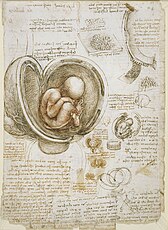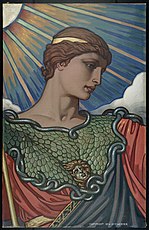
Drawing is a visual art that uses an instrument to mark paper or another two-dimensional surface. The instruments used to make a drawing are pencils, crayons, pens with inks, brushes with paints, or combinations of these, and in more modern times, computer styluses with graphics tablets or gamepads in VR drawing software.

An image is a visual representation. An image can be two-dimensional, such as a drawing, painting, or photograph, or three-dimensional, such as a carving or sculpture. Images may be displayed through other media, including a projection on a surface, activation of electronic signals, or digital displays; they can also be reproduced through mechanical means, such as photography, printmaking, or photocopying. Images can also be animated through digital or physical processes.

Kinetic art is art from any medium that contains movement perceivable by the viewer or that depends on motion for its effects. Canvas paintings that extend the viewer's perspective of the artwork and incorporate multidimensional movement are the earliest examples of kinetic art. More pertinently speaking, kinetic art is a term that today most often refers to three-dimensional sculptures and figures such as mobiles that move naturally or are machine operated. The moving parts are generally powered by wind, a motor or the observer. Kinetic art encompasses a wide variety of overlapping techniques and styles.

Protest art is the creative works produced by activists and social movements. It is a traditional means of communication, utilized by a cross section of collectives and the state to inform and persuade citizens. Protest art helps arouse base emotions in their audiences, and in return may increase the climate of tension and create new opportunities to dissent. Since art, unlike other forms of dissent, takes few financial resources, less financially able groups and parties can rely more on performance art and street art as an affordable tactic.
Mark Tansey is an American painter.

The term composition means "putting together". It can be thought of as the organization of the elements of art according to the principles of art. Composition can apply to any work of art, from music through writing and into photography, that is arranged using conscious thought.

Elihu Vedder was an American symbolist painter, book illustrator and poet from New York City. He is best known for his fifty-five illustrations for Edward FitzGerald's translation of The Rubaiyat of Omar Khayyam.

John Anthony Baldessari was an American conceptual artist known for his work featuring found photography and appropriated images. He lived and worked in Santa Monica and Venice, California.

Visual arts education is the area of learning that is based upon the kind of art that one can see, visual arts—drawing, painting, sculpture, printmaking, and design in jewelry, pottery, weaving, fabrics, etc. and design applied to more practical fields such as commercial graphics and home furnishings. Contemporary topics include photography, video, film, design, and computer art. Art education may focus on students creating art, on learning to criticize or appreciate art, or some combination of the two.
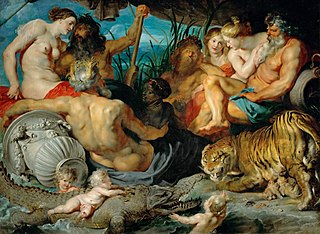
A work of art, artwork, art piece, piece of art or art object is an artistic creation of aesthetic value. Except for "work of art", which may be used of any work regarded as art in its widest sense, including works from literature and music, these terms apply principally to tangible, physical forms of visual art:
Visual design elements and principles describe fundamental ideas about the practice of visual design.
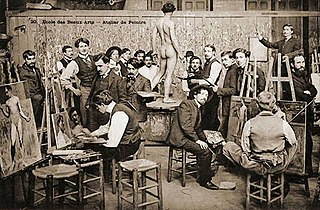
An atelier is the private workshop or studio of a professional artist in the fine or decorative arts or an architect, where a principal master and a number of assistants, students, and apprentices can work together producing fine art or visual art released under the master's name or supervision.

Anselm Reyle is a German visual artist, based in Berlin. He is known for his often large-scale abstract paintings and found-object sculptures.
The psychology of art is the scientific study of cognitive and emotional processes precipitated by the sensory perception of aesthetic artefacts, such as viewing a painting or touching a sculpture. It is an emerging multidisciplinary field of inquiry, closely related to the psychology of aesthetics, including neuroaesthetics.

Space art, also known as astronomical art, is a genre that focuses on visual representations of the universe. This genre includes various styles, such as realism, impressionism, abstract imagery, and sculpture. Though artists have long produced art with astronomical elements, the genre of space art itself began only when technological advancement allowed for more detailed observation of the night sky. Space art also attempts to communicate ideas related to space, often including an artistic interpretation of cosmological phenomena and scientific discoveries. In some cases, space artists use more than illustration and painting to communicate astronomy or works depicting space. Several space artists work directly with scientists developing spaceflight technology in attempts to expand the arts, humanities, and cultural expression relative to space exploration.

Painting is a visual art, which is characterized by the practice of applying paint, pigment, color or other medium to a solid surface. The medium is commonly applied to the base with a brush, but other implements, such as knives, sponges, and airbrushes, may be used.

The visual arts are art forms such as painting, drawing, printmaking, sculpture, ceramics, photography, video, filmmaking, comics, design, crafts, and architecture. Many artistic disciplines, such as performing arts, conceptual art, and textile arts, also involve aspects of the visual arts as well as arts of other types. Also included within the visual arts are the applied arts, such as industrial design, graphic design, fashion design, interior design, and decorative art.
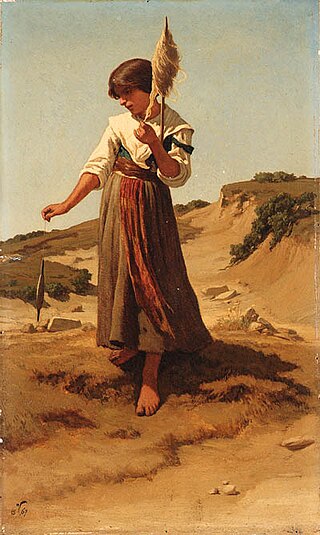
Peasant Girl, spinning is the title given by nineteenth century American expatriate artist Elihu Vedder to an oil painting on canvas that depicts a young female figure spinning wool into thread. The work was completed in 1867 at the artist's studio in Via Margutta, Rome, and represents a slightly scaled up, slightly elaborated version of a theme Vedder had first developed in an oil sketch during the summer of the same year.
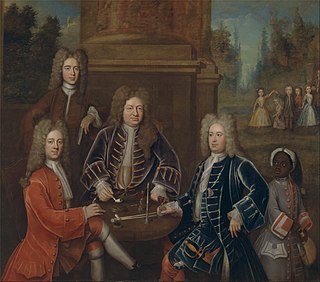
Elihu Yale with Members of his Family and an Enslaved Child is a group portrait of Elihu Yale with William Cavendish and his brother James in England. It is currently in the collection of the Yale Center for British Art. It is attributed to John Verelst and has been dated to 1719.
Janice Gurney is a Canadian contemporary artist born in Winnipeg, Manitoba. She graduated University of Manitoba in 1973 with a Bachelor of Fine Arts Honours degree and later received a Master of Visual Studies degree from University of Toronto in 2007 with a collaborative degree in Book History and Print Culture. She went on to get a PhD in Art and Visual Culture at Western University in 2012.

